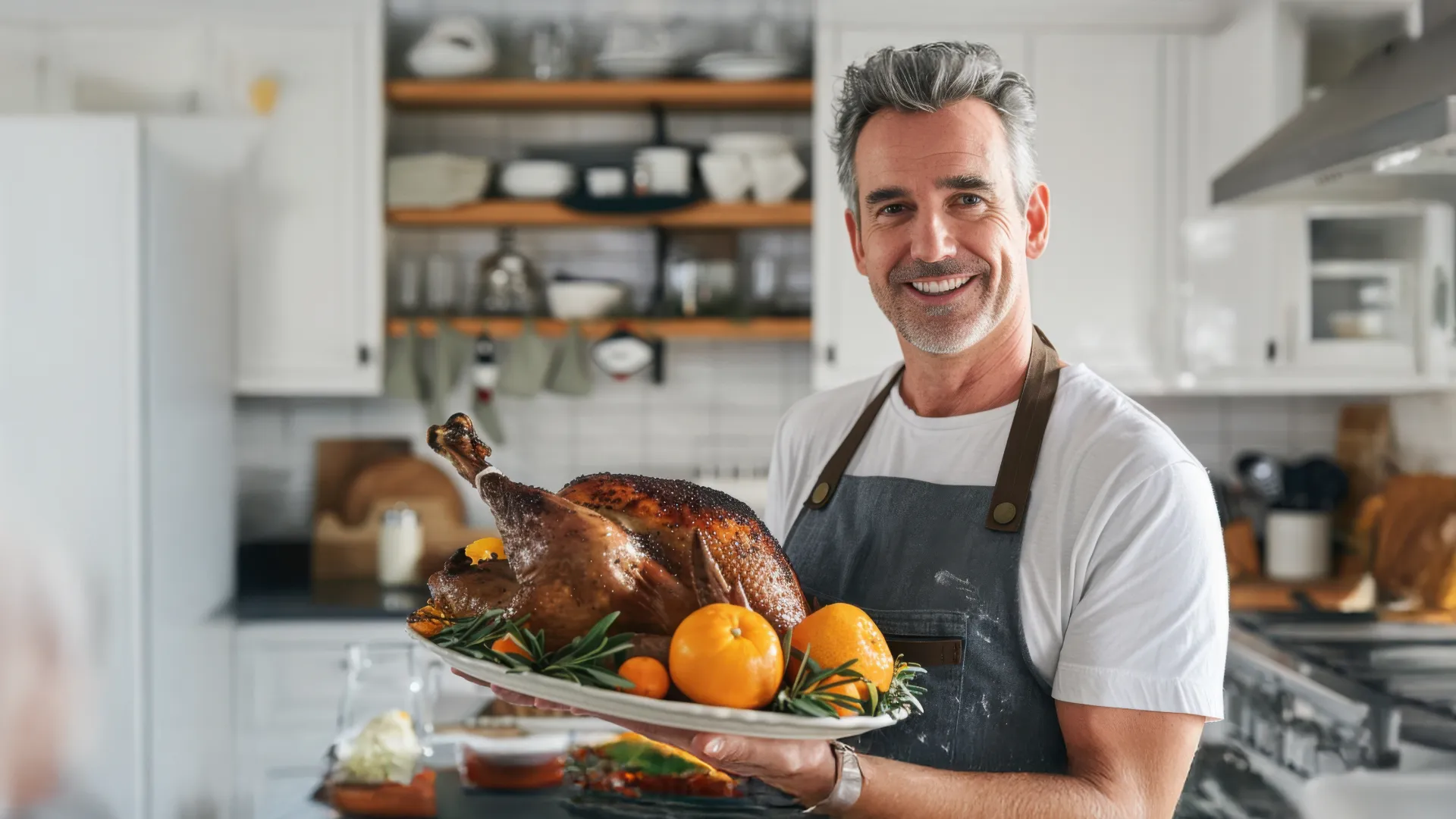Glucose, and Smart “Biohacking” Through the Holiday Week
For a lot of people, Thanksgiving is a cheat day.
For the Fitter Over Fifty tribe, it’s something else: a stress test.
Bigger meals. Less sleep. More sugar and alcohol. Travel. Extra family stress layered on top.
At 25, you could walk it off.
At 50+, the same pattern can echo for days.
This isn’t about fear of food or skipping dessert. It’s about understanding the levers you control so you can enjoy the holiday and still feel like yourself tomorrow.
This week, think in three layers:
- What changes in your metabolism as you age
- How you can use nutrition to steer the ship
- Where “biohacking” tools like keto strategies, ketones, peptides, and wearables actually fit
Why Holiday Food Hits Harder Now
Thanksgiving meals stress three systems at once:
- Blood sugar control
- Inflammation and recovery
- Digestion
As you get older, the terrain underneath shifts.
Insulin sensitivity tends to drop.
Your body needs a stronger signal to move the same amount of sugar out of your blood and into your muscles or liver. That means those rolls, stuffing, and pie lead to steeper spikes and deeper crashes.
Muscle mass quietly shrinks if you don’t defend it.
Muscle is your best storage for glucose. Less muscle means a smaller sponge. The carbs that used to disappear into active tissue now hang around longer.
Sleep lightens and becomes easier to disturb.
Late meals, alcohol, strange beds, and blue light hit harder. When sleep suffers, so does glucose control the next day.
Baseline inflammation inches up.
Big meals, stress, and lack of movement stack more quickly. You feel it in your joints, your head, your mood.
None of this is a moral failure. It’s simple physiology. The win is not avoiding Thanksgiving. The win is walking in with a plan.

Start With the Plate, Not the Gadget
Biohacking tools are fun. We’ll get to them. First, your plate.
1. Lead With Protein
When you build your Thanksgiving plate, think like this:
Protein first.
Plants next.
Carbs on purpose.
Put one to two palm-sized servings of protein down before anything else:
- Turkey
- Roast beef or ham, if that’s on your table
- Higher-protein sides if you’re more plant forward
Protein:
- Blunts the impact of the carbs coming behind it
- Helps you feel satisfied, not sleepy
- Supports muscle retention and recovery
If you already use a protein shake or collagen in the morning, keep that routine. You are not “saving calories” by skipping breakfast; you’re starting the day under-fueled.
2. Frame It With Plants
Next layer: fiber and color.
Aim for at least a third of your plate in vegetables:
- Roasted Brussels sprouts, carrots, squash
- Green beans or other non-starchy sides
- A real salad if someone brought one
Fiber slows digestion, smooths your glucose curve, and feeds your gut. That matters more than ever when the rest of the plate is richer than usual.
3. Choose Carbs You Actually Love
Thanksgiving offers ten different starches. You probably care about two of them.
Pick your favorites and let the rest go:
- Stuffing and mashed potatoes
- Sweet potato casserole
- Rolls, cornbread, mac and cheese
You don’t have to be low carb to be strategic. You just move from “automatic sampling” to real choice. Eat them slowly, sitting down, with your phone away so your brain and gut can stay in the same conversation.
4. Dessert, On Purpose
You can enjoy dessert without treating it like a contest.
- Pick the dessert that is truly worth it.
- Eat one serving and pay attention to how it tastes and how you feel.
- If you want more, give yourself twenty minutes. You may still say yes. You might not.
You’re not being graded. You’re simply trading autopilot for awareness.

Where Keto and Ketones Fit (If You Use Them)
Talk of keto and ketones is everywhere, especially in the biohacking crowd. Here’s a simple way to think about it during the holidays.
Keto as a pattern.
When you follow a ketogenic diet, you lower carbs enough that your body leans more on fat and ketones for fuel. Many people report more stable energy and fewer cravings.
Ketones as a fuel.
Your liver can make ketones during fasting, low-carb eating, or long aerobic work. You can also drink them in the form of exogenous ketone products.
During Thanksgiving week:
- If you already eat low carb most of the time, your body may handle the extra carbs from one or two meals better, simply because your baseline is tighter.
- If you use exogenous ketones, they can sometimes smooth out energy during travel days or busy mornings, but they don’t cancel out over-eating or turn pumpkin pie into health food.
The main point: keto and ketones are fuel strategies, not moral upgrades. If they help you feel more stable, great. If not, you haven’t failed. You’ve learned something about your own chemistry.

Peptides: Advanced Tool, Not Holiday Fix
Peptides are having a moment.
There are:
- Food-derived peptides, like collagen peptides in your coffee
- Protein powders that include smaller peptide chains
- Prescription-grade therapeutic peptides used under medical supervision
They can be useful tools for joint support, recovery, body composition, and more. They can also be misused when people treat them as shortcuts instead of amplifiers.
For Thanksgiving week, here’s the filter:
- If you’re already working with a knowledgeable clinician, follow the plan you’ve built together.
- If you’re not, don’t let holiday guilt push you into chasing an injection you heard about on social media.
Peptides can enhance a strong foundation. They cannot build one for you. Protein, plants, movement, and sleep still drive ninety percent of the result.

Biohacking Layer: Use Tech to Learn, Not to Beat Yourself Up
If you like tech, Thanksgiving is a good time to run a few experiments.
Continuous Glucose Monitor (CGM)
If you’re wearing a CGM:
- Watch what happens when you eat protein and vegetables first versus carbs first.
- Notice what a ten-minute walk after the meal does to your curve.
- Compare two desserts on different days.
You are not aiming for a perfect, flat line. You are building personal intelligence about how your body reacts.
Wearables and Sleep
Whoop, Oura, Garmin, Apple Watch—they all give you some version of sleep quality and recovery.
Try this:
- The night before Thanksgiving, protect your usual bedtime.
- On Thanksgiving night, see what happens if you cut screens an hour before bed, even if you stay up later.
- At least one night this weekend, limit alcohol and see how your HRV and resting heart rate respond.
The goal is not to obsess over every number. It’s to spot patterns you can actually act on in December and beyond.

A Three-Day Thanksgiving Game Plan
You don’t need a spreadsheet. Just a rhythm.
The Day Before
- Get at least one strength session in, even if it’s just thirty minutes. Focus on big movements: squats, pushes, pulls, carries.
- Hydrate well. Travel and salty food ride easier when you are not starting dehydrated.
- Go to bed close to your normal time.
Thanksgiving Day
Morning:
- Eat breakfast. Make it protein-forward: eggs, Greek yogurt, cottage cheese, leftovers from the fridge, or a shake. Skipping breakfast usually backfires as overeating later.
- Grab some daylight and a short walk.
Main meal:
- Build your plate in the order we talked about: protein, plants, then carbs you actually want.
- Eat without rushing. Put your fork down between bites a few times and breathe.
After the meal:
- Go for a walk, even if it’s just ten minutes around the block with someone you like. This is one of the simplest glucose “hacks” there is.
Evening:
- If you drink, pick a reasonable amount and match each drink with water.
- Give yourself a buffer between last bite and bedtime where you are not eating more.
The Day After
- Do not “punish fast” or try to outrun the meal with a brutal workout.
- Return to your normal eating pattern as quickly as possible: protein at each meal, plenty of water, vegetables back on the plate.
- A light training session or longer walk can help you feel better, not “pay for” yesterday.

Aging Defiantly Includes Pie
It’s easy to slide into all-or-nothing thinking:
Either you are “on plan” and skipping everything fun,
or you are “off plan” and Thanksgiving becomes a four-day food spiral.
Neither is required.
Healthy aging is not about never eating sugar again or saying no to your favorite holiday dishes. It is about building enough capability and awareness that one big meal doesn’t throw you for a week.
This Thanksgiving:
- Lead with protein and plants.
- Treat carbs and dessert as chosen, not automatic.
- Use any biohacking tools you already have as a way to learn, not to judge.
- Let advanced tools like peptides stay in their proper place: long-term strategy, not holiday panic buttons.
You’re not here to age quietly. You’re here to enjoy the people you love, savor the food on your plate, and still wake up the next morning with a body you can count on.
That’s what aging defiantly looks like at the holiday table.




